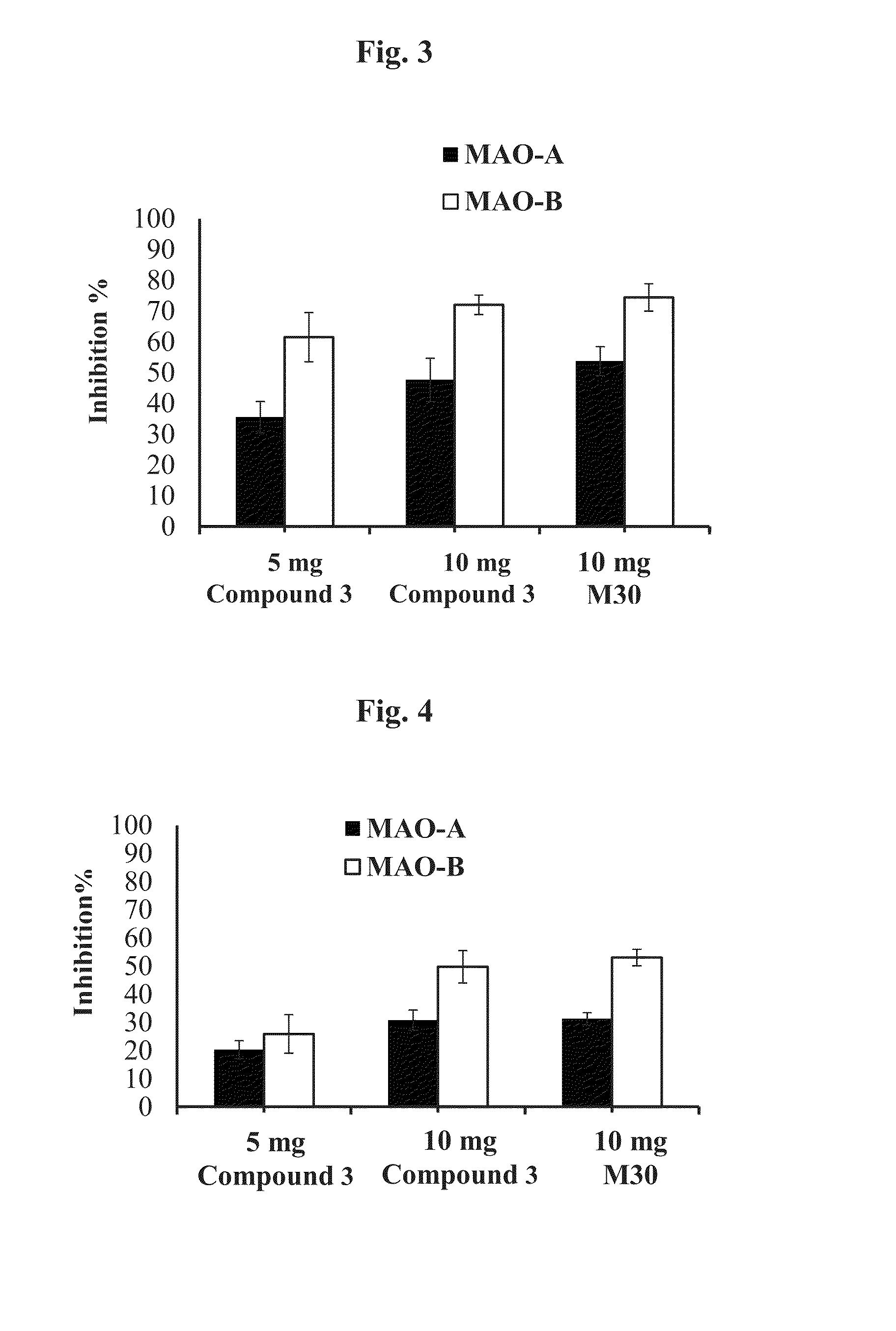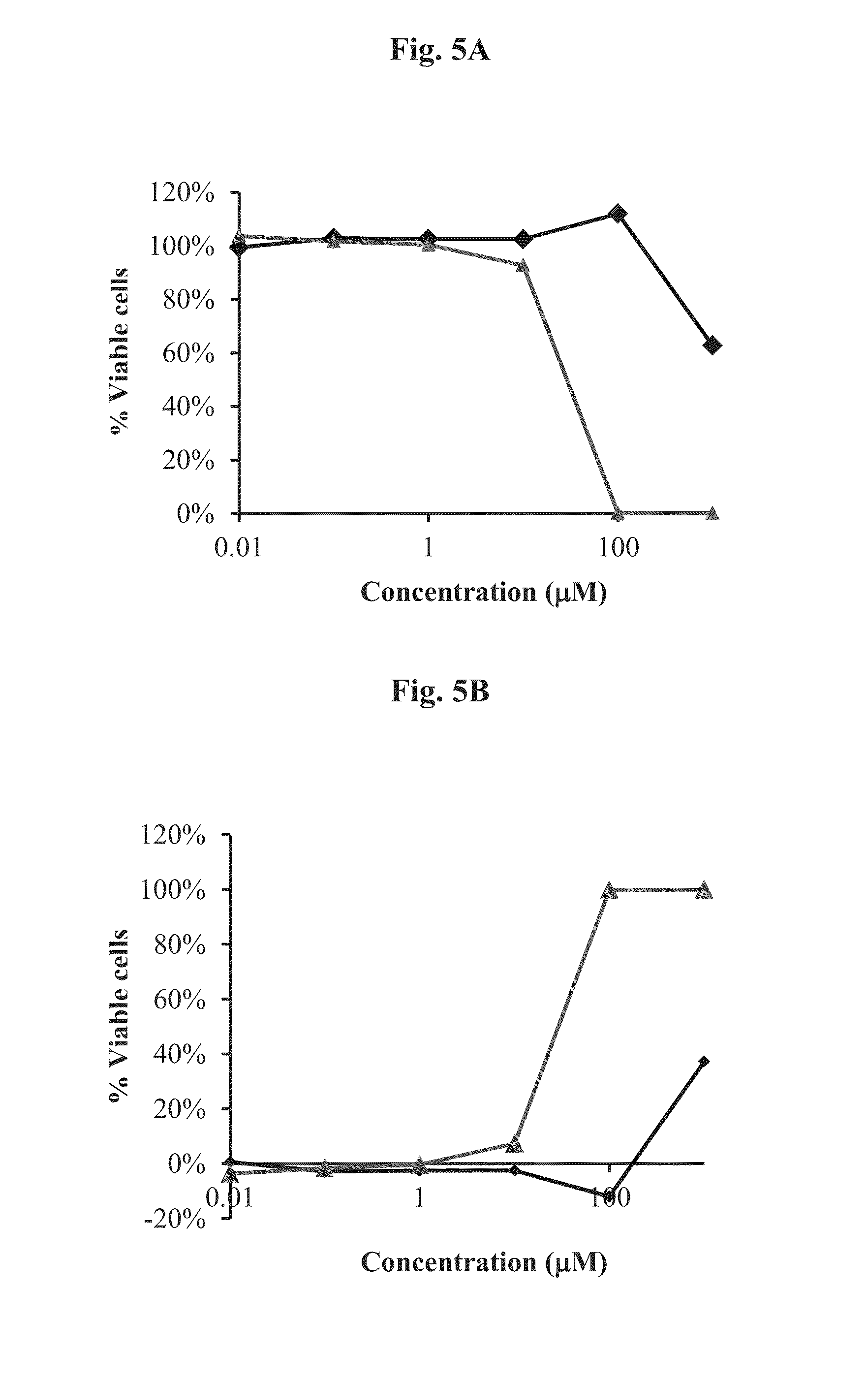Neuroprotective and neuro-restorative iron chelators and monoamine oxidase inhibitors and uses thereof
a neuroprotective and neuro-restorative technology, applied in the field of quinoline, can solve the problems of forming an increasing economic burden for society, lipid peroxidation of cell membranes, and stimulating oxidative damage, and achieve optimal or sufficient oral uptake and pharmacokinetics (pk), good transport properties in lipophilic media
- Summary
- Abstract
- Description
- Claims
- Application Information
AI Technical Summary
Benefits of technology
Problems solved by technology
Method used
Image
Examples
example 1
Synthesis of 5-[(methyl-2-propyn-1-ylamino)methyl]-8-quinolinol (M30)
[0140]The synthesis of M30 is described herein below:
[0141]A mixture of 14.6 g (0.1 mol) of 8-quinolinol, 16 mL of 32% HCl in water, and 16 mL (0.1 mL) of 37% formaldehyde in water at 0° C. was treated with hydrogen chloride gas for 6 h. The solution was allowed to stand at room temperature for 2 h without stirring. The yellow solid obtained was collected on a filter, washed with 90% alcohol and dried under vacuum to give 5-chloromethyl-8-quinolinol hydrochloride A (19.0 g, 98%): 1H NMR (250 MHz, CDCl3, δ) 5.32 (s, 2H), 7.53 (m, 1H), 7.85 (m, 2H), 8.12 (m, 1H), 9.12 (m, 1H), 9.28 (m, 1H).
[0142]To a mixture of 5-chloromethyl-8-quinolinol hydrochloride A (2.707 g, 11.8 mmol) and diisopropylethylamine (DIPEA; 2.1 mL, 20.4 mmol, 2 eq) in 50 mL CHCl3 at 0° C. was added N-methyl-N-propargylamine (10.2 mmol, 1 eq). The mixture was stirred for 24 h at room temperature. CHCl3 (100 mL) was added and the solution obtained was...
example 2
Syntheses of esters of M30
[0143]The syntheses of esters of M30 are described herein below:
[0144]A solution of 1 eq M30 and 1.1 eq triethylamine (TEA) in tetrahydrofuran (THF) is treated by dropwise addition under a nitrogen atmosphere with a solution of 1 eq of the corresponding acid chloride (e.g., for R═—CH3, acetyl chloride) in THF. After completion (TLC or HPLC analysis), the mixture is concentrated in vacuo and the residue is partitioned between ethyl acetate and water. The organic phase is dried with magnesium sulfate and evaporated in vacuo. The crude product is purified by crystallization or by column chromatography.
[0145]In this way the following esters can be prepared, having at the 8-position the groups: —OCOCH3, —OCOCH2CH3, —OCOCH(CH3)CH2CH2CH3, —OCOCH2CH(CH3)2, —OCOCH2Cl, —OCOCH2OCH3, —OCOCH2CH2OCH2CH3, —OCOCH═CH2, —OCOC(CH3)═CH2, —OCOCH═CH(CH3), —OCOCH═CHPh, —OCOCH2CH2CH═CH2, —OCOCH═C(CH3)2, —OCOCF3, —OCOCH2CO2CH3, —OCOCH2O2CCH3, —OCO(4-methoxyphenyl), —OCO(2-thienyl),...
example 3
Syntheses of amino acid esters of M30
[0146]The syntheses of amino acid esters of M30 are described herein below:
[0147]Using the procedure of Song, et al. (J. Med. Chem., 2005, 48, 1274-1277), t-butoxycarbonyl (Boc) protected amino acids (5 eq), N,N-dicyclohexylcarbodiimide (DCC; 5 eq), and 4-dimethylaminopyridine (DMAP; 0.5 eq) are allowed to react with M30 (1 eq) in dry dimethylformamide (DMF) at room temperature for 24 h. The reaction is filtered and the DMF is removed in vacuo. The residue is dissolved in ethyl acetate and washed with water and brine. The organic layer is dried over magnesium sulfate and concentrated in vacuo. Purification is carried out by column chromatography. In the case of aspartic and glutamic acids, the t-butyl protected beta and gamma carboxylic acids, respectively, are utilized. The purified products are treated with trifluoroacetic acid (TFA): dichloromethane (DCM) [1:1]. After 4 h the solvents are removed in vacuo and the residues reconstituted with wa...
PUM
| Property | Measurement | Unit |
|---|---|---|
| Pharmaceutically acceptable | aaaaa | aaaaa |
Abstract
Description
Claims
Application Information
 Login to View More
Login to View More - R&D
- Intellectual Property
- Life Sciences
- Materials
- Tech Scout
- Unparalleled Data Quality
- Higher Quality Content
- 60% Fewer Hallucinations
Browse by: Latest US Patents, China's latest patents, Technical Efficacy Thesaurus, Application Domain, Technology Topic, Popular Technical Reports.
© 2025 PatSnap. All rights reserved.Legal|Privacy policy|Modern Slavery Act Transparency Statement|Sitemap|About US| Contact US: help@patsnap.com



